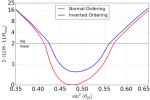In a paper recently published in Physical Review D, the IceCube Collaboration reports on measurements of the all-particle cosmic ray energy spectrum and composition in the PeV to EeV energy range using three years of data from the IceCube Neutrino Observatory. […]
Research
IceCube and PICO set new constraints on properties of dark matter particles
Dark matter is one of the biggest mysteries in modern astronomy and physics. In a paper recently submitted to the European Physical Journal C, scientists from IceCube and PICO determined new constraints on particle physics properties of dark matter. Though these are less stringent than previous constraints, they take into consideration the latest research on the distribution of dark matter in our galaxy. […]
New all-sky search reveals potential neutrino sources
After 10 years of searching for origins of astrophysical neutrinos, a new all-sky search provides the most sensitive probe of time-integrated neutrino emission of point-like sources. The IceCube Collaboration presents the results of this scan in a paper submitted today to Physical Review Letters. […]
Testing a new technique to search for neutrino point-source populations
The IceCube Collaboration performed a search for point-source populations using a technique called the non-Poissonian template fit (NPTF) and published their findings in a paper submitted to The Astrophysical Journal. This was the first time the NPTF was used on IceCube neutrino data, and while they did not find any neutrino point-source populations, they proved the technique’s viability. […]
How to deal with “dust” in the Antarctic ice
The IceCube Neutrino Observatory is an array of over 5,000 optical sensors embedded in a cubic kilometer of ice at the South Pole. Optical impurities in the ice affect how light travels through the IceCube detector and thus how the neutrino interactions appear. In a technical paper submitted to the Journal of Cosmology and Astroparticle Physics, the IceCube Collaboration presents a new method to understand the optical properties of the ice, called the SnowStorm method. […]
IceCube looks for extremely energetic gamma rays from the Milky Way
While the IceCube Neutrino Observatory is mostly known for detecting neutrinos, it is also the experiment most sensitive to PeV-scale gamma rays in the Southern Hemisphere. In a recent paper by the IceCube Collaboration submitted to The Astrophysical Journal, they discuss the results of a recent search for PeV gamma rays. No evidence of PeV gamma rays were found, but they established the most stringent constraints on PeV gamma-ray emission to date. […]
An important step towards understanding neutrino masses
In a new paper by the IceCube Collaboration, physicists use the inner and denser DeepCore detector within IceCube to try to answer this question. A weak preference is shown for NO, a result that is complementary to and in agreement with results from other experiments. This paper has been submitted to the European Physical Journal. […]
Improving searches for galactic sources of high-energy neutrinos
In a recent paper by the IceCube Collaboration, two new techniques have improved searches at energies from 100 TeV down to 100 GeV. When tested with a few years of IceCube data, these new selections improve the sensitivity and discovery potential, for the first time allowing the search for galactic point-like sources using track events created by muon neutrinos, which in many cases are indistinguishable from atmospheric muon tracks. These results have just been submitted to the journal Astroparticle Physics . […]
Pan-STARRS1 far vision at the service of neutrino sources
In a recent publication submitted to Astronomy and Astrophysics, the IceCube Collaboration and Pan-STARRS1 scientists have searched for counterpart transient optical emission associated with IceCube high-energy neutrino alerts. When following five alerts sent during 2016-17, researchers found one supernova worth studying, SN PS16cgx. However, a more detailed analysis showed that it is most likely a Type Ia supernova, i.e., the result of a white dwarf explosion, which is not expected to produce neutrinos. […]
Learning from blazars, a long-term neutrino–gamma-ray partnership
In a new paper by the IceCube Collaboration in partnership with scientists from the Fermi-LAT collaboration and the ASAS-SN telescopes, researchers went back to eight years of archived IceCube.
The results of this long-term search of high-energy neutrino emission from blazars confirm that this type of active galaxy cannot account for the majority of the diffuse neutrino flux seen by IceCube and that the source of most of the high-energy neutrinos is still unknown. These results have recently been submitted to Astronomy and Astrophysics. […]









